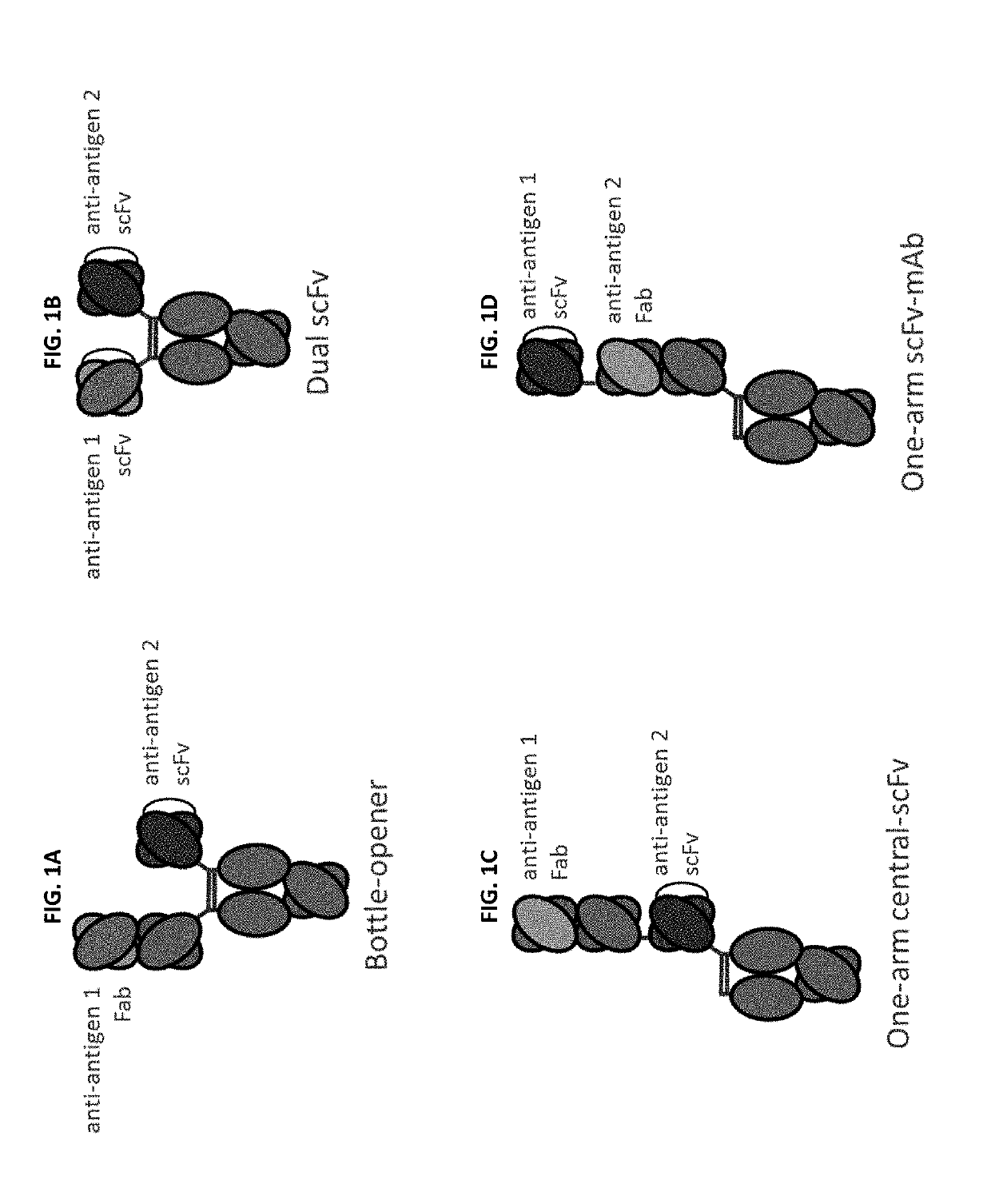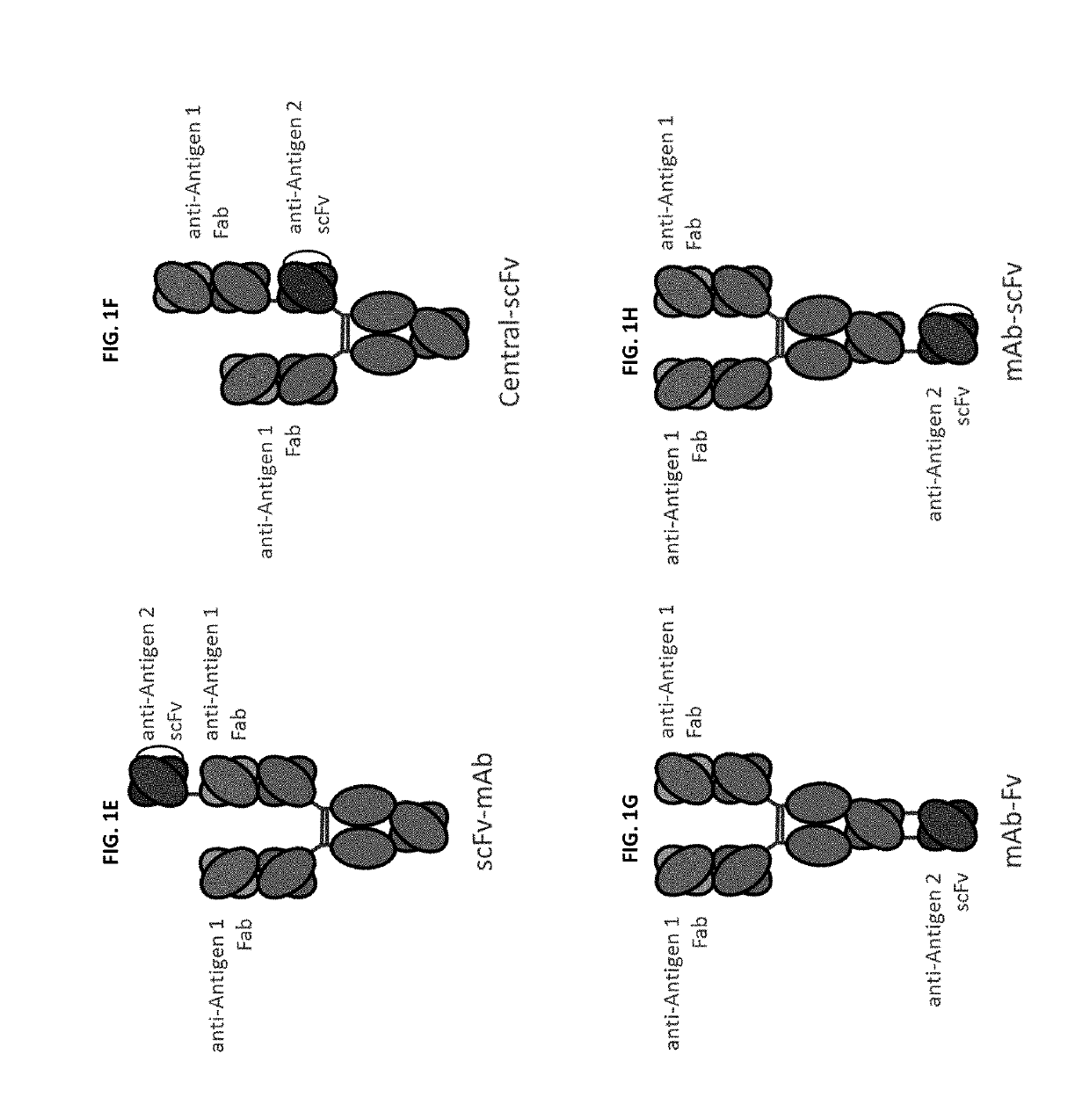Bispecific and monospecific antibodies using novel Anti-pd-1 sequences
a technology of monospecific antibodies and sequences, which is applied in the direction of antibody medical ingredients, drug compositions, peptides, etc., can solve the problems of many patients halting therapy and high financial burden of combinatorial therapy with such agents
- Summary
- Abstract
- Description
- Claims
- Application Information
AI Technical Summary
Benefits of technology
Problems solved by technology
Method used
Image
Examples
example 7
G. Triple Checkpoint Blockade with XmAb22841 and aPD-1 Enhances Cytokine Secretion from SEB-Stimulated Cells
[0524]Human PBMCs were stimulated with 100 ng / mL SEB for 2 days. Cells were washed two times and restimulated with 100 ng / mL SEB and 20 μg / mL indicated test articles for 24 hours. Cell supernatants were collected and assayed for IFNγ and IL-2 secretion as depicted in FIG. 29 and FIG. 30. The data show that triple checkpoint blockade enabled by a combination of XmAb22841 and XENP16432 (a bivalent αPD-1 mAb with ablated effector function based on nivolumab) enhance cytokine secretion beyond either XENP16432 or XmAb22841 alone. Notably, the combination of XmAb22841 and XENP16432 enhances cytokine secretion to a similar level as triple checkpoint blockade by a combination of XENP16432, XENP16433 (a bivalent αCTLA-4 mAb with ablated effector function based on ipilimumab), and XENP16436 (a bivalent αLAG-3 mAb with ablated effector function based on 25F7).
example 8
H. Avidity of XmAb22841 is Responsible for Cytokine Release from MLR
[0525]PBMCs from 2 unique donors were mixed (400,000 cells / donor) and incubated with the 20 μg / mL of the indicated test articles for 5 days. Following incubation, cells were assayed for IFNγ as depicted in FIG. 31. In a similar experiment, mixed PBMCs were incubated with various concentrations of indicated test articles for 5 days, and fold induction of IFNγ over PBS are depicted in FIG. 32. The data show that XmAb22841 enhances IFNγ secretion beyond a combination of XENP24895 (one-arm monovalent mAb based on anti-LAG-3 arm of XmAb22841) and XENP24893 (one-arm monovalent mAb based on anti-CTLA-4 arm of XmAb22841) demonstrating that avidity enabled by bivalent binding is necessary for enhancing cytokine release.
I. Example 9: Triple Checkpoint Blockade with XmAb22841 and αPD-1 Enhance GVHD in NSG Mice
[0526]NOD SCID gamma (NSG) mice (10 per group) were engrafted via IV-OSP with 10×106 human PBMCs on Day 0. On Day 1, m...
example 10
J. Triple Checkpoint Blockade with XmAb22841 and αPD-1 Enhances Anti-Tumor Response in Mice
[0527]NOD SCID gamma (NSG) mice (10 per group) were engrafted intradermally with 3×106 pp65-expressing MCF-7 cells in the rear flank on Day−14. On Day 0, mice were engrafted intraperitoneally with 5×106 human PBMCs from an HLA matched CMV+ donor that screened positive for T cell pp65 reactivity (or PBS for control mice). Mice were treated weekly with XENP16432, XmAb22841, a combination of XmAb22841 and XENP16432, or PBS (for control mice) for 4 weeks (4 total doses). Tumor volumes were monitored by caliper measurements, data for which are shown (days post 1st dose) in FIGS. 36A-36B. Blood was drawn on Day 7, 12, 19, and 26 and analyzed by flow cytometry to count various lymphocyte populations as depicted in FIGS. 37A-37D. The data show that lymphocyte counts (in particular CD8+ T cells) were similar with or without the various checkpoint inhibitors. However, treatment with the various test ar...
PUM
 Login to View More
Login to View More Abstract
Description
Claims
Application Information
 Login to View More
Login to View More - R&D
- Intellectual Property
- Life Sciences
- Materials
- Tech Scout
- Unparalleled Data Quality
- Higher Quality Content
- 60% Fewer Hallucinations
Browse by: Latest US Patents, China's latest patents, Technical Efficacy Thesaurus, Application Domain, Technology Topic, Popular Technical Reports.
© 2025 PatSnap. All rights reserved.Legal|Privacy policy|Modern Slavery Act Transparency Statement|Sitemap|About US| Contact US: help@patsnap.com



